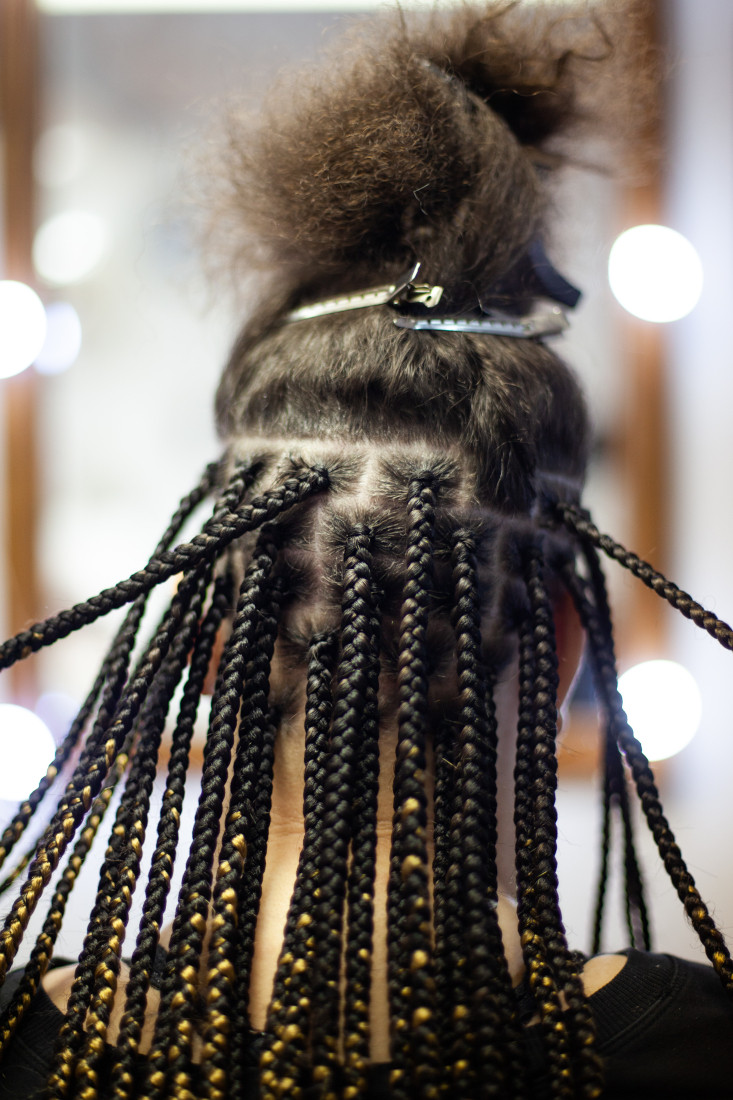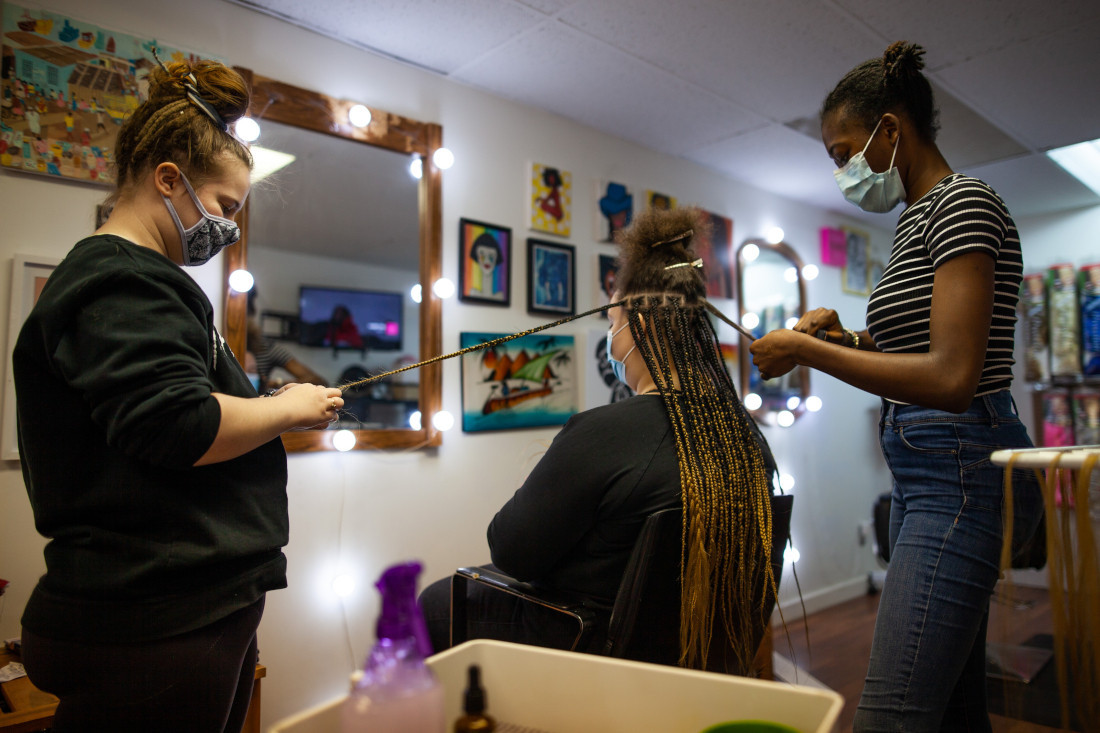This is our hair
The artistry of African-style braiding
This is our culture
“Growing up, this is what we do,” local stylist and owner of BraidsbyKemLis, Kemi Lisoyi, says.
“Our parents, this is what they do for us. This is what we know. We don’t get to stretch our hair or do anything like that. We just get to wash and put it in cornrows, or you braid it, so it’s part of what we are made of, and it’s Black.”
Lisoyi – originally from Nigeria – has braided for seven years. Like most local African braid specialists, she began braiding for her inner circle of family and friends. From there, her client base grew. Now, her skillset has become quite varied.
“I’m pretty much a jack of all trades,” she says. “I can do box braids, knotless braids ... I also do dreads. I do hair colouring and cornrows.”
On top of all that, she makes wigs, too.
But even with the accomplishment Lisoyi feels when she successfully completes the looks her clients request, she’s aware of a deeper connection that braiding has to Black culture.
“I had a client who ... (is) Black, but all her life she has been here, so she really knows nothing about the Black culture,” Lisoyi says.
“Our appointment was just for an hour and a half, and she decided to stay for two extra hours just for us to talk about the Black community, because she felt left behind when we were doing Black Lives Matter.”
With the time each appointment can take (ranging anywhere from an hour to possibly 10, depending on the style), there’s an incredible opportunity to bond and meet new people.
Twenty-two-year-old hairstylist Francine Oyoa takes great joy in this opportunity when working on her clients’ hair.
“I’ve met a lot of people from different countries,” she says. “Nigeria, Ethiopia – especially Ethiopia ‘cause a lot of my clients are from Ethiopia. I’ve even met people from Zambia.”
Through her budding braiding business, France’s Coiffure, Oyoa has shared moments with her clients that remind her how unifying braiding is for African people.
Specifically, she’s noticed that while people from different parts of Africa might have different names for a certain look, the hairstyle itself is the same.
“It defines us all,” Oyoa says. “Although we call it different names, it is the same thing.”
In this way, braiding provides an organic space to explore an aspect of the culture that’s universal to Black people, no matter their country of origin. But more than that, it’s an essential component of self-care.
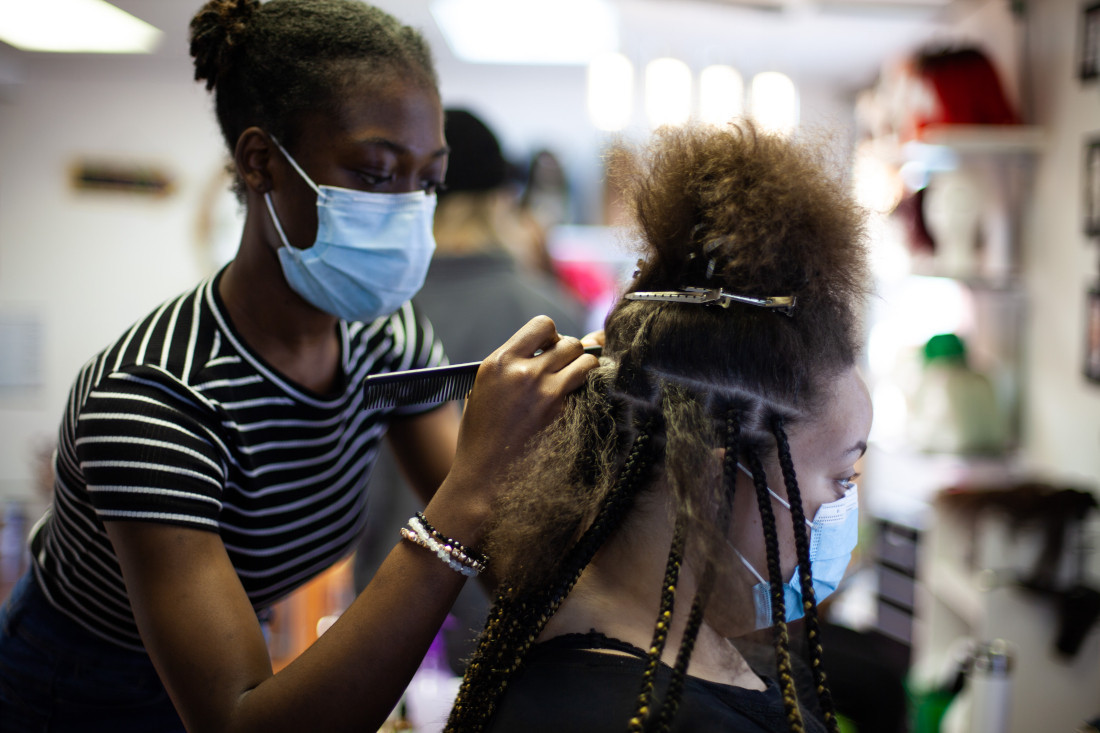
Anjola Odejayi (left) parts Tunyia Scutter’s (right) hair into sections with a comb.
This is our self-care
Nadia Wera-Asghedom, a hairstylist and the owner of Hairbru, pays careful attention to how hair translates to a person’s well-being.
“It is an investment in a part of your life,” Wera-Asghedom says, “the same way you (invest) in your skin.”
African braids are protective hairstyles. Meant to last for weeks at a time, they are as beautiful as they are functional, shielding Black hair from harsher elements. Yet the process of having braids installed is not easily endured.
“A lot of people have traumas of taking care of their hair in terms of pain or how it looks or how hard it is to take care of,” she says.
For a lot of Black women, haircare becomes something of a lifelong journey.
“Black hair is so versatile,” Wera-Asghedom says. “It ranges from texture to texture, and the way you take care of it is also different.”
While each Black woman’s journey is very much her own, there’s a profound resonance in knowing that, no matter what the hair texture, this self-care endeavour is uniquely Black.
“Our hair is different,” she says, “but also the same.”
Even with the pain, it’s common for Black kids to have braids installed at a young age. Despite the physical discomfort, the practice has a few key benefits.
“One: it’s protective,” Wera-Asghedom says. “Two: it’s a way of showing who you are, your identity. Three: it’s a confidence-booster.”
Considering how hair is so tightly bound in a Black person’s perception of their own self-worth and identity, determining which professional to go to for braids or any sort of treatment is not a decision that’s made lightly.
“It’s not just braiding,” Oyoa says. “There’s more behind the braiding.”
In fact, braiding involves assessing the current state of a client’s hair and offering advice for achieving strong ends in the long run. Oyoa considers a great deal when working with a client’s hair: everything from the hair’s texture and history to the client’s hair goals. She admits it’s not easy work, but it’s well worth it to see a gorgeous, healthy style take root.
“Braiding isn’t easy at all,” Oyoa says. “I stand there for hours braiding people’s hair, and sometimes their hair texture can be a challenge. So seeing them leave with this smile, I’m not gonna lie: that’s my motivation ... that’s everything.”
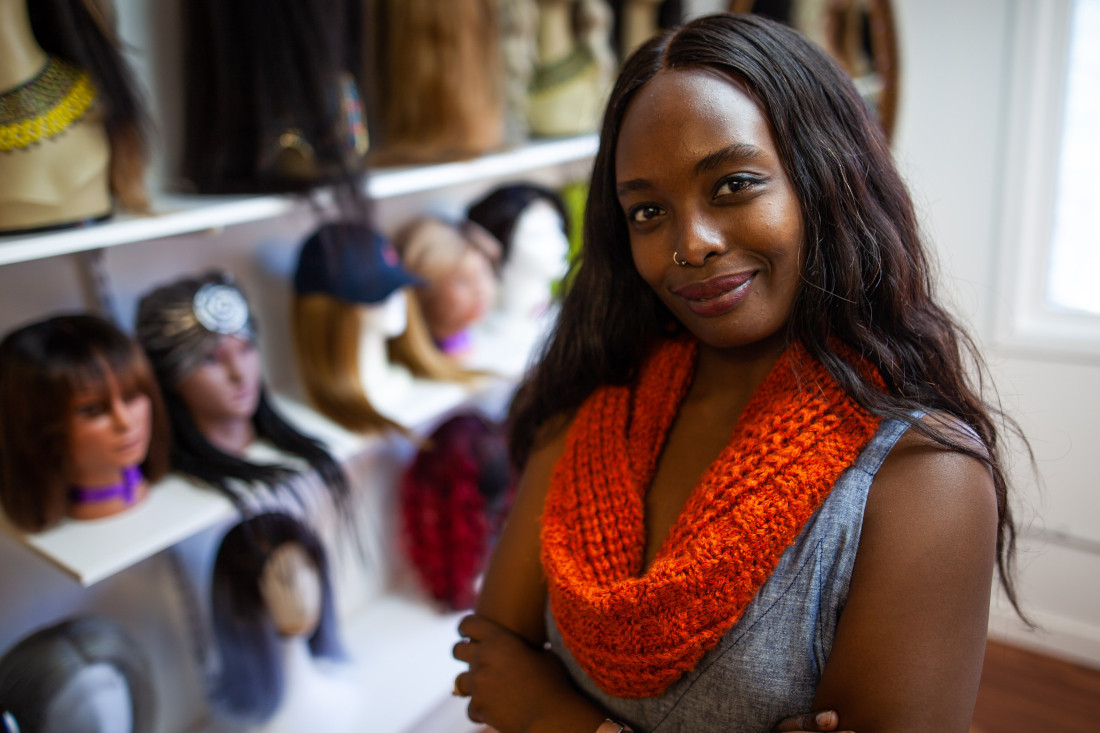
“A lot of people have traumas of taking care of their hair in terms of pain or how it looks or how hard it is to take care of.” - Nadia Wera-Asghedom, owner and hairstylist at Hairbru
This is our artistry
It’s indisputable that African-style braids fall beyond the bounds of what can be considered a normal hairstyle. In short, braids are art. With that, there’s a great deal of accomplishment felt when a braided hairstyle is finally completed.
“We’re creating a hairstyle that’s not very common,” Wera-Asghedom says. “It’s like canvas, and you want to help that person create that vision they have in their mind.”
More often than not, clients tend to come in with an image of a unique style they want. Most of the time, stylists won’t have the exact blueprint on how to achieve that look, but instead have the skill and technique to learn on the fly and recreate it in the moment.
“When I have clients that bring new styles, I don’t say ‘I don’t know how to do it,’” Liyosi says. “I say ‘I can do it,’ (and) I just give it a shot.”
Often, the look comes together, and it’s deeply rewarding for the stylist. What’s more, as new innovative styles continue to be developed for braids, more Black people tend to opt for those looks to feel their best.
“There was a time where you only do braids for regular days,” Oyoa says, “and then have a weave for your birthday.”
Now, Oyoa notices more and more clients are requesting braids for special occasions.
“Honestly, that makes me so happy,” she says.
At Hairbru, Wera-Asghedom and her team will often incorporate free accessories and beads into the styles their clients request to make their hair look extra special. Again, seeing the end result is deeply fulfilling.
“It’s that satisfaction of ‘wow, we did that,’” Wera-Asghedom says, “and tomorrow, it’s going to be something different.”
The moment the hair is complete – often after several hours – is meaningful to everyone involved. The physical relief, for one, is immense, but to see the accumulation of Black culture, effort and precise technical skill come together into one hairstyle – it’s magical.
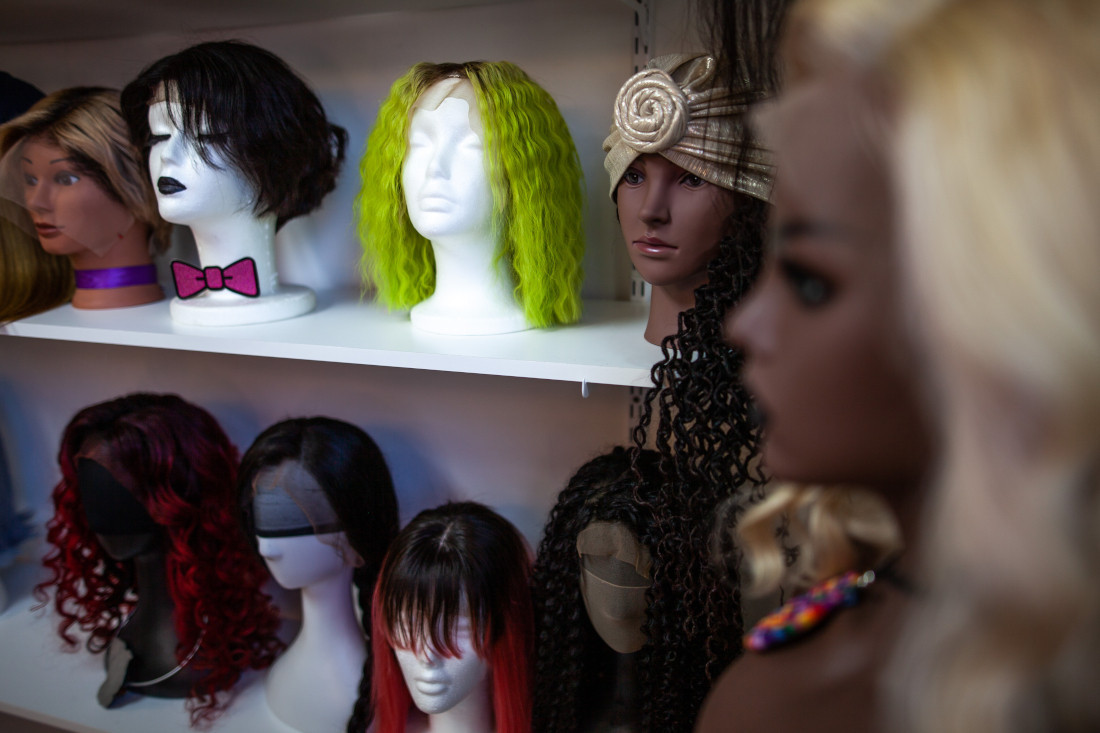
A selection of wigs for sale at Hairbru
This is our heritage
Beyond the emotional, creative and cultural depth that’s embedded in the ongoing art that is African-style braiding, there’s a certain spirit that comes with keeping this part of Black culture alive.
“I’m just happy we can make the culture continue while we are here in Canada,” Lisoyi says. “Being able to render the service to other Black communities, even out of the
Black countries, is really an honour.”
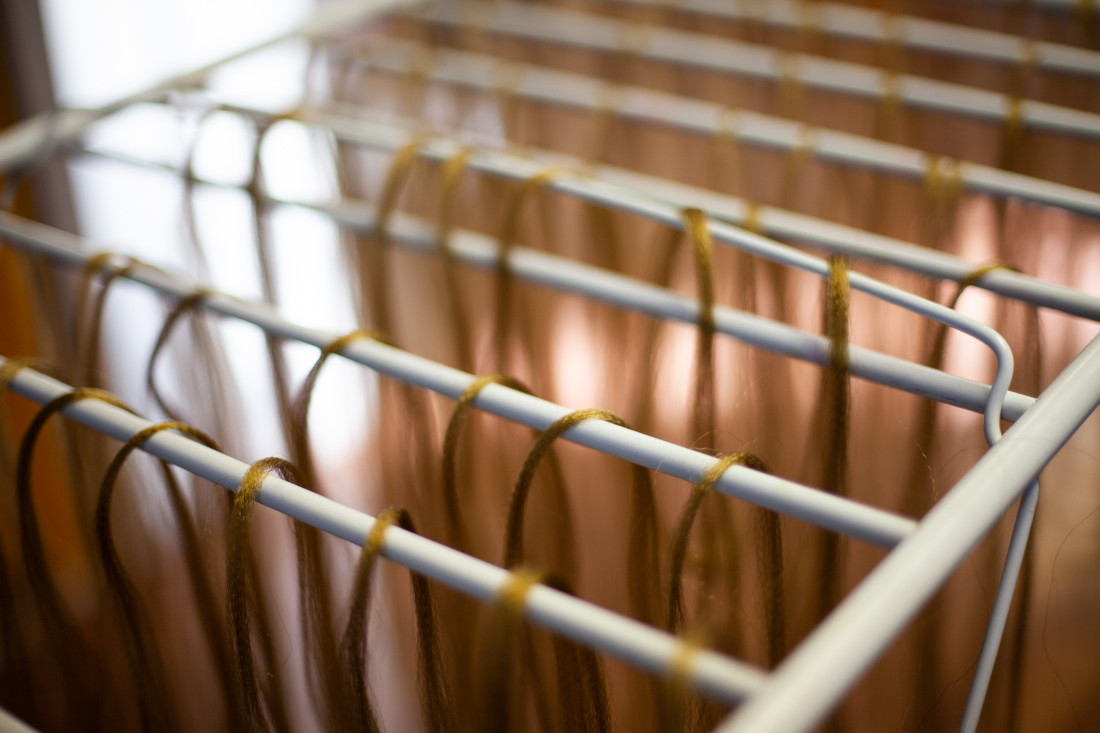
“I’m just happy we can make the culture continue while we are here in Canada.” - Kemi Liyosi, owner and stylist at BraidsbyKemLis
The history and weight of African-style braids is palpable, even to those who were not raised in the culture. As a result, it’s typical for Black people – Black women in particular – to experience a great deal of curiosity around and questions about their braided hair. Sometimes, this curiosity can be invasive.
“I feel like hair is personal,” Wera-Asghedom says. “If you want to get to know somebody, the best way is to ask, not invade their personal space. Then it creates that avenue for conversation. They get to know who I am, why I am the way I am, why I wear my hair the way I’m wearing it.”
Ultimately, teaching the culture behind African-style braids is another way to keep the understanding of it alive. It’s considerably gracious for anyone to freely share information regarding their heritage, especially if they’re asked while going about their day-to-day life.
“I used to be very angry about it,” Wera-Asghedom says, “but then I also realized ‘well, who else is gonna tell them?’”
“The more people know about how to deal with Black hair, the more free and accepting (they) will be.”
Regardless, offering support and appreciation to Black hairstylists is an excellent way to create a respectful avenue for understanding. Endorsements, via follows and shares on social media accounts, is especially important for those who braid hair out of their homes. After all, they keep a crucial piece of Black culture alive.
“It came from Africa,” Wera-Asghedom says. “It’s an art of braiding.”
“It’s Black. Period.” {media-5}
Follow Kemi Lisoyi on Instagram at @kemi_lis, Francine Oyoa at @francescoiffure and Hairbru at @ms_hairbru.
Published in Volume 76, Number 09 of The Uniter (November 12, 2021)

